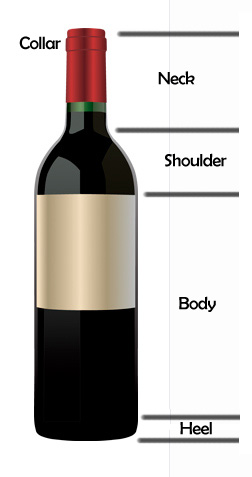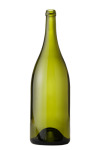 bottles
bottles Entries in bottles (1)
The Anatomy Of A Bottle
 Wednesday, August 25, 2010 at 2:17PM
Wednesday, August 25, 2010 at 2:17PM Bottling last week got me thinking more about the  beautiful glass vessels whose shape we associate so strongly with wine. The anatomy of the bottle borrows much of its terminology from the anatomy of the human body: The bottom of the bottle is called the base, heel or insweep. The characteristic indentation on the bottom of the wine bottle is known as the kick-up, push-up or (perhaps most commonly) the punt. The punt if you’re wondering, as I often have, is primarily to add strength to the bottle but it also aids in collecting any sediment that may be present in the wine. This was a critical innovation and it’s likely that we would not have sparkling wine today without it. The body is the portion of the bottle where the sides are straight. The slope that leads from the body to the neck is appropriately called the shoulders and this is where bottles derive most of their style. The raised ring around the neck is called the collar which adds strength to the bottle and allows any sort of tamper-protective covering to grip the bottle. The mouth of the bottle you can probably surmise is the opening on top. The finish refers to the style of the neck as it relates to how the wine is sealed. For example a wine could have a cork finish or a screw-cap finish. All wine bottles have these features, they simply differ in appearance.
beautiful glass vessels whose shape we associate so strongly with wine. The anatomy of the bottle borrows much of its terminology from the anatomy of the human body: The bottom of the bottle is called the base, heel or insweep. The characteristic indentation on the bottom of the wine bottle is known as the kick-up, push-up or (perhaps most commonly) the punt. The punt if you’re wondering, as I often have, is primarily to add strength to the bottle but it also aids in collecting any sediment that may be present in the wine. This was a critical innovation and it’s likely that we would not have sparkling wine today without it. The body is the portion of the bottle where the sides are straight. The slope that leads from the body to the neck is appropriately called the shoulders and this is where bottles derive most of their style. The raised ring around the neck is called the collar which adds strength to the bottle and allows any sort of tamper-protective covering to grip the bottle. The mouth of the bottle you can probably surmise is the opening on top. The finish refers to the style of the neck as it relates to how the wine is sealed. For example a wine could have a cork finish or a screw-cap finish. All wine bottles have these features, they simply differ in appearance.
 Burgundy
Burgundy Hock
Hock Claret
Claret
Like so much of the wine world, the modern bottle is a reflection of both function and tradition. Bottles have likely been used to store wine since the time of Christ but it wasn’t until the 17th century that glass bottles became common. The shape of the wine bottle has evolved over time but today there are several conventions that are firmly rooted in culture. The two most popular styles are the claret bottle, which originated in Bordeaux, and the burgundy bottle. The claret was popularized in the mid 19th century though it is possible it was in use by the French well before then. It has a body that features almost parallel sides although sometimes there is a slight taper where the shoulder is wider than the heel (this greatly complicates labeling). The body is long and narrow and the shoulder is short and sharply curved. The burgundy bottle is fatter with long shoulders that when combined with the neck is about equal to the length of the body. The punt is usually smaller except for champagne bottles which require the added strength. The bottles are associated closely with not only region but also varietal. Pinot Noir is always bottled in the burgundy style bottle, as is Chardonnay. Cabernet Sauvignon and other Bordeaux varietals such as Merlot are strongly associated with claret bottles. A third prevalent style that is slightly less common is the Hock or Rhine shape. These slender bottles have curves that flow from the heel to the collar so that the body shoulder and neck flow together. This style is typically associated with the German varietals Riesling and Gewurztraminer. There are many subtle nuances within each style and the options of bottles available to a winemaker are staggering. Deerfield always uses high quality glass because after all, the bottle that the wine is in represents it, like the clothes that you choose to wear.
 bottles
bottles 
